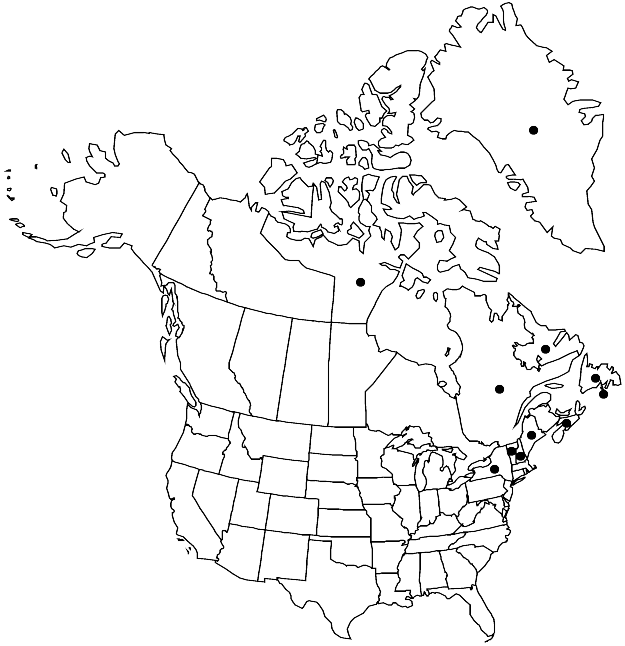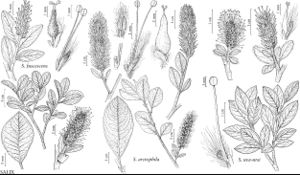Salix uva-ursi
Fl. Amer. Sept. 2: 610. 1813.
Plants 0.01–0.05 m, (dwarf), forming clonal compact mats by layering. Stems prostrate, short-trailing; branches redbrown, gray-brown, or yellowbrown, glabrous; branchlets yellow-green or yellowbrown, glabrous or puberulent. Leaves: stipules (sometimes marcescent) absent, rudimentary, or foliaceous on early ones, foliaceous on late ones; petiole (shallowly to deeply grooved adaxially), 2–6.5 mm; largest medial blade (marcescent), amphistomatous or hypostomatous, ovate, broadly obovate, oblanceolate, or elliptic, 4–23 × 3.5–10 mm, 1.7–3.6 times as long as wide, base convex or cuneate, margins flat, serrulate or crenulate, apex convex, acuminate, acute, or retuse, abaxial surface glaucous, usually glabrous (rarely few hairs), adaxial slightly or highly glossy, usually glabrous (rarely a few hairs); proximal blade margins entire or serrate; juvenile blade glabrous, pilose, or puberulent abaxially. Catkins: staminate 9–19 × 5–8 mm, flowering branchlet 0.5–9 mm; pistillate densely flowered, slender to subglobose, 11–47 (–55 in fruit) × 6–10 mm, flowering branchlet 2–10 mm; floral bract brown, black, tawny, light rose, or bicolor, 1.1–1.8 mm, apex rounded or acute, entire, abaxially sparsely hairy, hairs straight or wavy. Staminate flowers: abaxial nectary absent, adaxial nectary narrowly oblong or oblong, 0.4–0.9 mm; filaments distinct, glabrous; stamens usually 1, rarely 2; anthers ellipsoid or shortly cylindrical, 0.4–0.7 mm. Pistillate flowers: abaxial nectary absent, adaxial nectary narrowly oblong or oblong, 0.5–0.8 mm, shorter to longer than stipe; stipe 0.3–1.6 mm; ovary ovoid or pyriform, glabrous, beak gradually tapering to styles; ovules 4–9 per ovary; styles 0.4–1 mm; stigmas flat, abaxially non-papillate with rounded tip, or slenderly cylindrical, 0.1–0.23–0.4 mm. Capsules 3–5 mm. 2n = 38.
Phenology: Flowering mid Jun-early Aug.
Habitat: Exposed, often dry or moist, calcareous, serpentine, dioritic, and granitic rocks, boulders, gravel, sand on beaches, outcrops, in snowbeds
Elevation: 10-1200 m
Distribution

Greenland, St. Pierre and Miquelon, Nfld. and Labr., N.S., Nunavut, Que., Maine, N.H., N.Y., Vt.
Discussion
Hybrids:
Salix uva-ursi forms natural hybrids with S. herbacea.
Selected References
None.
Lower Taxa
"-0.4mm" is not declared as a valid unit of measurement for this property.
